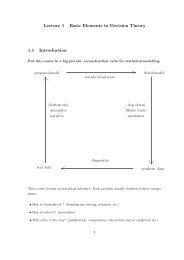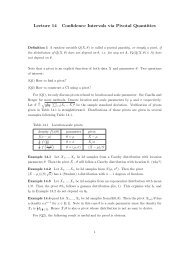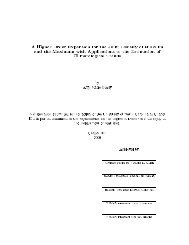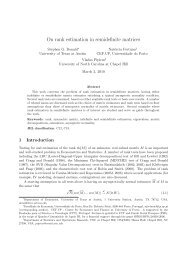Monte Carlo Methods in Statistical Mechanics: Foundations and ...
Monte Carlo Methods in Statistical Mechanics: Foundations and ...
Monte Carlo Methods in Statistical Mechanics: Foundations and ...
Create successful ePaper yourself
Turn your PDF publications into a flip-book with our unique Google optimized e-Paper software.
(plus a little auxiliary computation) on the nestgridalone|irrespective of the total<br />
number of levels. The most common choices are = 1 (which is called the V-cycle) <strong>and</strong><br />
=2(the W-cycle).<br />
Convergence proofs. For certa<strong>in</strong> classes of Hamiltonians H |primarily quadratic<br />
ones|<strong>and</strong>suitable choices of the coarse grids, prolongations, smooth<strong>in</strong>g iterations<br />
<strong>and</strong> cycle control parameters, it can be proven rigorously 18 that the multi-grid iteration<br />
matrices Ml satisfy a uniform bound<br />
jjMljj C < 1 (5.35)<br />
valid irrespective of the total number of levels. Thus, a xed number of multi-grid<br />
iterations (maybe ve orten) are su cient toreduce the error to asmall value, <strong>in</strong>dependent<br />
of the lattice sizeL. Inother words, critical slow<strong>in</strong>g-down has been completely<br />
elim<strong>in</strong>ated.<br />
The rigorous convergence proofs are somewhat arcane, so we cannot describe them<br />
here <strong>in</strong> anydetail, but certa<strong>in</strong> general features are worth not<strong>in</strong>g. The convergence proofs<br />
are most straightforward when l<strong>in</strong>ear or higher-order <strong>in</strong>terpolation <strong>and</strong> restriction are<br />
used, <strong>and</strong> >1 (e.g. the W-cycle). When either low-order <strong>in</strong>terpolation (e.g. piecewiseconstant)<br />
or =1(the V-cycle) is used, the convergence proofs become much more<br />
delicate. Indeed, if both piecewise-constant <strong>in</strong>terpolation <strong>and</strong> a V-cycle are used, then<br />
the uniform bound (5.35) has not yet been proven, <strong>and</strong> itismostlikely false! To some<br />
extent these features may be artifacts ofthe current methods of proof, but we suspect<br />
that they do also re ect real properties of the multi-grid method, <strong>and</strong> sotheconvergence<br />
proofs may serve asguidance for practice. For example, <strong>in</strong> our work wehave used<br />
piecewise-constant<strong>in</strong>terpolation (so as to preserve the simple nearest-neighbor coupl<strong>in</strong>g<br />
on the coarse grids), <strong>and</strong> thus for safety westick tothe W-cycle. Thereis<strong>in</strong>any case<br />
much room for further research, both theoretical <strong>and</strong> experimental.<br />
To recapitulate, the extraord<strong>in</strong>ary e ciency of the multi-grid method arises from the<br />
comb<strong>in</strong>ation of two key features:<br />
1) The convergence estimate (5.35). This means that onlyO(1) iterations are needed,<br />
<strong>in</strong>dependent ofthe lattice size L.<br />
2) The work estimate (5.34). This means that eachiteration requires only a computational<br />
labor of order L d (the ne-grid lattice volume).<br />
It follows that the complete solution of the m<strong>in</strong>imization problem, to any speci ed<br />
accuracy ", requires a computational labor of order L d .<br />
Unigrid po<strong>in</strong>t of view. Let us look aga<strong>in</strong> at the multi-grid algorithm from the variational<br />
st<strong>and</strong>po<strong>in</strong>t. One natural class of iterative algorithms for m<strong>in</strong>imiz<strong>in</strong>g H are the<br />
18 For a detailed exposition of multi-grid convergence proofs, see [32, Chapters 6{8, 10, 11], [40] <strong>and</strong><br />
the references cited there<strong>in</strong>. The additional work needed to h<strong>and</strong>le the piecewise-constant <strong>in</strong>terpolation<br />
can be found <strong>in</strong>[41].<br />
35







